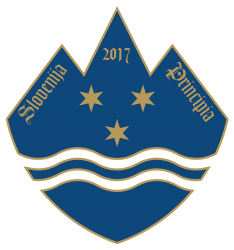Our first Saturday was spent in the “city/town” of Celje visiting the museum in the Princely Palace, a pedagogical tree house, and the Celje castle. During this visit, we learned all about the counts of Celje, their history, their lives, their castles, and we spent some time with our hosts: forest manager Boštjan Hren and his family–Alenka, Oskar, and Erazem; as well as professor and translator Jason Blake and his family–Alenka and Nina.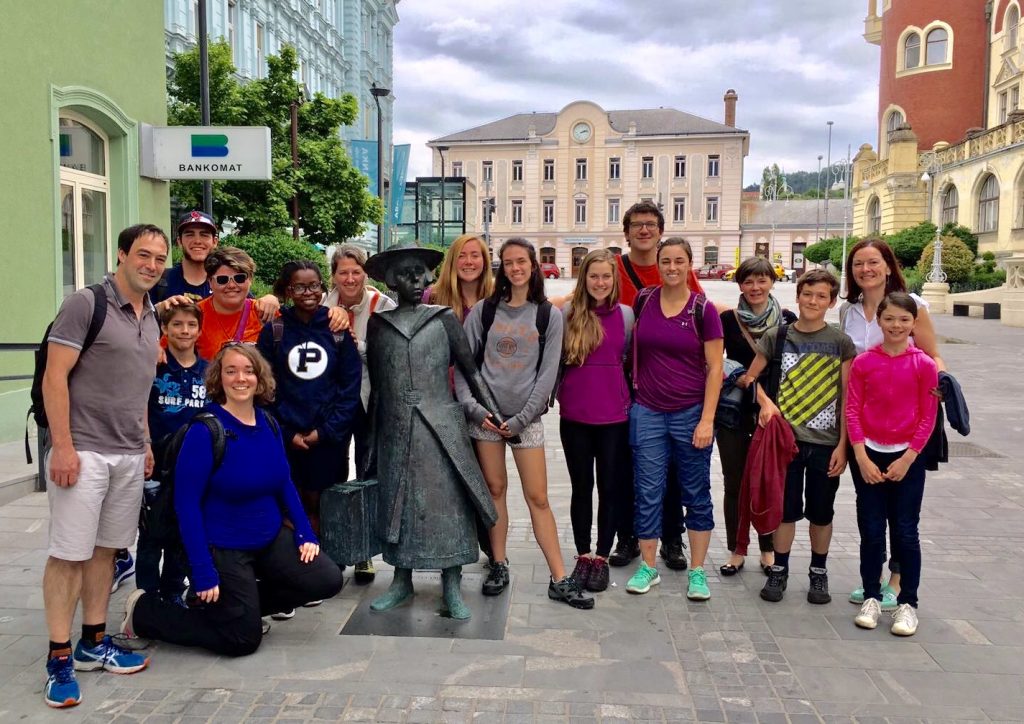
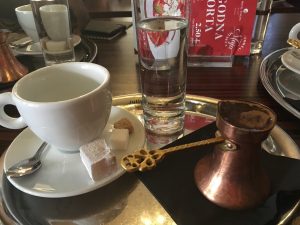 After an hour-long drive we met our hosts at in the cafe at Hotel Evropa where many of us drank the famous Turkish coffee before headingto Pokrajinski Muzej. At the museum, we toured the castle/palace where the counts of Celje used to live. The most recent castle was built on top of an old Roman road and fortifications of the city of Celeia. During Roman rule, the structure was used as barracks and for military protection. Signs of Roman heating and sewage systems are on display in a below-ground exhibition of Roman ruins found and left in situ. At one point our tour group was standing in what had been the moat. As proof, the castle ruins show three ground floors because each time it was rebuilt (three distinct times after conquests by such enemies as Attila the Hun) the ground floor was built higher and higher because of the rising water level. (After our museum visit our hosts showed us the new Celje information center, where more Roman ruins are displayed in situ in the city center. They were discovered in 2015 when the town was upgrading a pedestrian area.)
After an hour-long drive we met our hosts at in the cafe at Hotel Evropa where many of us drank the famous Turkish coffee before headingto Pokrajinski Muzej. At the museum, we toured the castle/palace where the counts of Celje used to live. The most recent castle was built on top of an old Roman road and fortifications of the city of Celeia. During Roman rule, the structure was used as barracks and for military protection. Signs of Roman heating and sewage systems are on display in a below-ground exhibition of Roman ruins found and left in situ. At one point our tour group was standing in what had been the moat. As proof, the castle ruins show three ground floors because each time it was rebuilt (three distinct times after conquests by such enemies as Attila the Hun) the ground floor was built higher and higher because of the rising water level. (After our museum visit our hosts showed us the new Celje information center, where more Roman ruins are displayed in situ in the city center. They were discovered in 2015 when the town was upgrading a pedestrian area.)
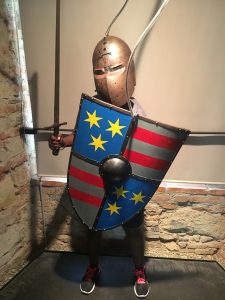 During medieval times, the castle and its walls sported marble representative of the Roman era. Marble statues were displayed in the house as a form of decoration. During the tour, we each got to put on the helmet of a knight, which was heavy, and hold a shield and sword. Overall, there were 18 counts of Celje, and their skulls (carbon dated for identification purposes) can be found in this museum in an eerie gallery.
During medieval times, the castle and its walls sported marble representative of the Roman era. Marble statues were displayed in the house as a form of decoration. During the tour, we each got to put on the helmet of a knight, which was heavy, and hold a shield and sword. Overall, there were 18 counts of Celje, and their skulls (carbon dated for identification purposes) can be found in this museum in an eerie gallery.
This, however, was not the only castle owned by the counts of Celje. They owned 250 other castles, and we got to visit another one, the Celje castle. It’s more of a ruin–a fortified castle more than a palace–and you can see the whole town from the top of the Frederick Tower. It is an amazing view. During our exploration of the Celje castle, we were told two stories about the counts: one of Frederick and Veronica, and the other of Barbara and the end of the line of the counts of Celje.
Barbara, daughter of one of the counts, was queen of three countries. She was married to the Roman emperor Sigsimund of Luxembourg at the age of thirteen and thus became the Empress. Later, she was also crowned queen of Bohemia, Germany, and Hungary. She gave birth to only one child, Elizabeth, who in turn gave birth to children whose descendants can be traced up to the Queen of England. Barbara showcased high intelligence as she spoke seven languages and managed different estates; she once lent money to her husband when he was in trouble.
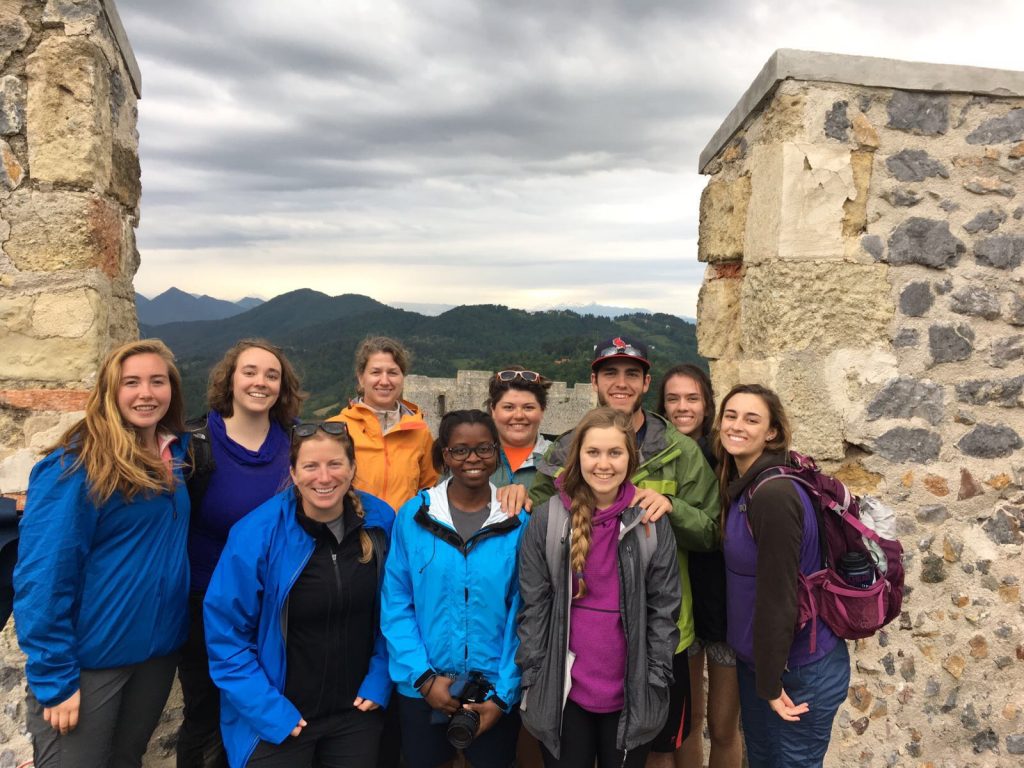 Now the story of Frederick and Veronika mirrors that of Romeo and Juliet to a certain degree. Frederick was a count, child of Herman II, while Veronika was just a lowly peasant. After the death of his wife, Frederick wanted to be with Veronica but his father disapproved. Veronika got accused of witchcraft and was brought in for trial. After her escape, she lived with monks for a while and then later was captured and drowned by Herman II’s army.
Now the story of Frederick and Veronika mirrors that of Romeo and Juliet to a certain degree. Frederick was a count, child of Herman II, while Veronika was just a lowly peasant. After the death of his wife, Frederick wanted to be with Veronica but his father disapproved. Veronika got accused of witchcraft and was brought in for trial. After her escape, she lived with monks for a while and then later was captured and drowned by Herman II’s army.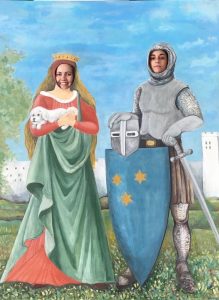
The last count, Ulrich II was killed by Hungarians. He wanted to rule and made a lot contributions to the empire, but since the Hungarians didn’t want him to, he was lured to Belgrade and killed. His funeral happened on November 8 in 1556; his shield was broken in half and the rule of the counts of Celje ended. All their property was seized by the Habsburg empire–the two families had signed an agreement that if one family’s line died out, the other would inherit the other’s lands and possessions–who in turn neglected the castles and tried to erase traces of the counts from the castle.
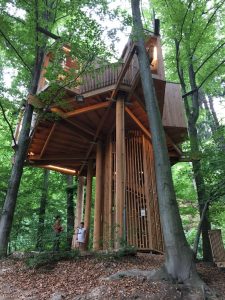 The highlight of the day for me was the tree house in the city forest. After a twenty-minute walk from lunch followed by a twenty-minute hike up hill, we arrived on the site of the tree house. It is a beautiful place in the middle of the woods of Douglas-fir trees. We ate ice cream brought by our hosts and listened to Erazum and Oskar play clarinet and guitar. Brooke played guitar, and then Oskar showed us some break dance moves.
The highlight of the day for me was the tree house in the city forest. After a twenty-minute walk from lunch followed by a twenty-minute hike up hill, we arrived on the site of the tree house. It is a beautiful place in the middle of the woods of Douglas-fir trees. We ate ice cream brought by our hosts and listened to Erazum and Oskar play clarinet and guitar. Brooke played guitar, and then Oskar showed us some break dance moves.
The day concluded with a traditional Slovenian meal at Francl, a restaurant locals take pride in, and another hour-long drive panicking about event maps due at midnight.
All in all, it was a day of learning and fun, and we are grateful Bostjan, Jason, and their families were able to share it with us.
~Genie
Genie Nyiramana is a junior majoring in computer science. She loves photography and is capturing lots of images around Slovenia. Her cultural studies subject is Slovenian Istria, including Piran.

